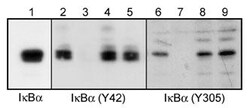Learn More
Invitrogen™ Phospho-IKB alpha (Tyr42) Polyclonal Antibody
Rabbit Polyclonal Antibody
Supplier: Invitrogen™ PA5143709
Description
This antibody was cross-adsorbed to phospho-tyrosine coupled to agarose then affinity purified using phospho-IkappaBalpha (Tyr-42) peptide (without carrier). The antibody detects a 38 kDa* protein on SDS-PAGE immunoblots of A431 and Jurkat cells treated with pervanadate, but not in control cells. Due to homologies to tyrosine sites on other proteins, it is recommended that the antibody be used to detect phosphorylation of immunoprecipitated IkappaBalpha.
IkB-alpha is a 40 kDa protein that functions to inhibit NF- kappaB activity. The inhibition occurs via protein-protein interaction between I kappaB proteins and NF- kappaB dimers in the cytosol. The interaction of I kappa B-alpha with NF- kappaB masks the nuclear localization sequence of NF- kappaB, preventing NF- kappaB translocation to the nucleus. A variety of stimuli can activate gene expression by liberating NF- kappaB through the degradation of I kappaB alpha. These stimuli include the proinflammatory cytokines TNF- alpha and IL-1 beta, chemokines, PMA, growth factors, LPS, UV irradiation, viral infection, as well as various chemical and physical stresses. In humans, the gene is located on the q arm of chromosome 14. Activation of NFkB requires that IkB be phosphorylated on specific serine residues, which results in targeted degradation of IkB. IkB kinase alpha (IKK alpha), previously designated CHUK, interacts with IkB-alpha and specifically phosphorylates IkB-alpha on the sites that trigger its degradation Serines 32 and 36. IKK alpha appears to be critical for NFkB activation in response to proinflammatory cytokines. Phosphorylation of IkB by IKK alpha is stimulated by the NFkB inducing kinase (NIK), which itself is a central regulator for NFkB activation in response to TNF and IL-1. The functional IKK complex contains three subunits, IKK alpha, IKK beta and IKK gamma, and each appear to make essential contributions to IkB phosphorylation.
Specifications
| Phospho-IKB alpha (Tyr42) | |
| Polyclonal | |
| Unconjugated | |
| NFKBIA | |
| AI462015; ECI-6; ECI-6/IKBA; I kappa B-alpha; I(Kappa)B(alpha); I79_018146; IkappaB alpha; IkappaBalpha; I-kappaBalpha; I-kappa-B-alpha; Ikba; IKBalpha; IKB-alpha; Inhibitor of nuclear factor of kappa light chain gene enhancer in B-cells alpha; Inhibitor of nuclear factor of kappa light chain gene enhancer in B-cells, alpha; MAD3; MAD-3; Major histocompatibility complex enhancer-binding protein MAD3; NF kappa B inhibitor alpha; NF-kappaB inhibitor alpha; NF-kappa-B inhibitor alpha; NFKB inhibitor alpha; NFKBI; Nfkbia; nuclear factor of kappa light chain gene enhancer in B-cells; nuclear factor of kappa light chain gene enhancer in B-cells inhibitor, alpha; nuclear factor of kappa light polyp gene enhancer in B-cell 1; nuclear factor of kappa light polypeptide gene enhancer in B cells inhibitor, alpha; nuclear factor of kappa light polypeptide gene enhancer in B-cells inhibitor, alpha; Rel-associated pp40; REL-associated protein pp40; RL/IF-1 | |
| Rabbit | |
| Antigen affinity chromatography | |
| RUO | |
| 18035, 25493, 4792 | |
| -20°C, Avoid Freeze/Thaw Cycles | |
| Liquid |
| Immunoprecipitation, Western Blot | |
| 0.125 mg/mL | |
| PBS with 1mg/mL BSA, 50% glycerol and 0.05% sodium azide | |
| P25963, Q63746, Q9Z1E3 | |
| NFKBIA | |
| IkappaBalpha (Tyr-42) synthetic peptide (coupled to KLH) corresponding to amino acid residues around tyrosine 42 of human IkappaBalpha. This peptide sequence has low homology to other IkappaB proteins, but does have some homology to unrelated proteins that may have a conserved tyrosine phosphorylation motif. | |
| 100 μL | |
| Primary | |
| Human, Mouse, Rat | |
| Antibody | |
| IgG |
Your input is important to us. Please complete this form to provide feedback related to the content on this product.
